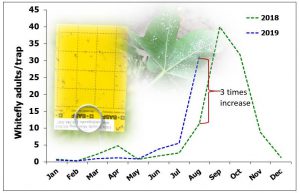Dr. Apurba Barman has been running a line of yellow sticky traps throughout southern Georgia for almost two years. These small traps are placed along roadways and changed and counted weekly. The trap lines include 125 locations stretching from Dothan, Alabama, to Reidsville, Georgia. The data collected from these traps are helping us to better understand both the spatial and temporal distribution of whiteflies in our region.
Surprisingly, Dr. Barman has collected adult whiteflies scattered throughout the region even in the dead of winter. We had always assumed they were overwintering primarily in our vegetable production areas, but they are distributed much more widely, even in the early Spring. Our vegetable production areas do end up with larger populations, but simply overwintering small populations is not the sole cause.
Of recent concern in the trap lines is the increase in populations since mid-July. The most recent counts indicate that we are at roughly 3 times the populations we experienced at the same time in 2018. Keep in mind, this is still well below what we experienced in 2017, but we do not have hard data for that comparison. These data do clearly point at concerns for population increase in the near future and possible impacts on fall vegetables.
Combined with these increasing populations, we have also detected tomato yellow leaf curl and cucurbit leaf crumple viruses this week. High populations and viruses can be devastating.
Of great interest, for a variety of reasons both good and bad, is hurricane Dorian. While no one wants winds and wind damage, if it will weaken and just drop a little rain across all of southern Georgia, it could help us greatly with whitefly problems this fall.
